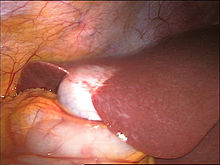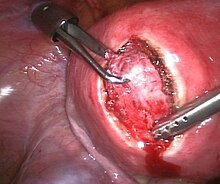Laparoscopic surgery
The laparoscopic surgery (of ancient Greek λαπάρα Lapara , German , switches ' , flanks', soft hollow portion between the ribs and the hips ', abdominal cavity', 'belly', and σκοπέειν / σκοπεῖν skopein , German , consider ' , look' , 'Examine') is a branch of surgery in which surgical operations within the abdominal cavity are performed with the help of an optical instrument ( endoscope ) and indirectly operated tweezers and knives via extensions . It is assigned to the complex of minimally invasive surgery ( MIC for short ).
Methods
The procedure used in laparoscopic surgery, the laparoscopy ("flank inspection"), LSK or LSC for short, or laparoscopy, describes methods in which the abdominal cavity and the organs located in it are carried out with special rod lens optics (rigid endoscopes) by the surgeon openings created in the abdominal wall are made visible. A trocar is inserted into the abdominal wall through a 0.3–2 cm long incision through which the abdominal cavity can be viewed with the help of a special endoscope (laparoscope) connected to a video camera and a light source. In a diagnostic laparoscopy, after the abdominal cavity has been inspected, the instrument is removed and the abdominal wall wound is closed with a suture or - depending on the findings - a therapeutic measure is added. During a surgical procedure, additional instruments are introduced through further, also 0.3–2 cm large incisions, with the help of which the operation can be carried out.
In the usual method, the abdomen is first filled with gas until a pneumoperitoneum is created. This can be done by different methods. One of them is that a surgical scalpel is used to make a small skin incision in the area of the navel (among other things, because the abdominal wall is thinnest there and the distance to the abdominal organs is greatest). Then the abdominal wall is pierced with a special insufflation cannula ( Veres cannula or Veres needle) only so far that its blunt tip, at which the insufflation opening is located, is finally free in the abdominal cavity. The tube of an insufflation pump can now be connected to the Veres cannula and the abdominal cavity can be “pumped up” with carbon dioxide (CO 2 ) so that a kind of “work and examination room” is created. The insufflation cannula is removed and a trocar is inserted “blindly”. The laparoscope is then inserted through this trocar. This allows the intra-abdominal space to be viewed.
This space (intra-abdominal space) now has to be made accessible for an endoscopic operation. For this purpose, depending on the type of surgery planned, as already described above, further small punctures are made in the abdominal wall, through which trocar sleeves, which close gastight, are inserted and securely anchored. These "keyhole openings", known in technical jargon as "trocar access", allow the endoscope and the special surgical instruments to be operated manually by the surgeon or assistant. With this method, side effects such as shoulder pain from irritation of the phrenic nerve can occur.
In a more recent, less common method, gasless laparoscopy, the abdominal wall is raised mechanically using a lift system.
Laparoscopic interventions
The following interventions can be performed laparoscopically:
- General surgery
- Emergency laparoscopy for abdominal trauma
- Clarification of unclear findings
- Investigations in tumor diseases
- Liver resection
- Further diagnostics of various diseases of all organs of the abdominal cavity
- Vagotomy
- Gallbladder removal (cholecystectomy)
- Interventions on the intestine :
- Removal of the appendix of the appendix (appendectomy)
- Hemicolectomy
- Sigma resection
- Rectal resection
- Rectopexy
- Ileocecal resection
- Colostomy
- Operations on the stomach :
- Treatment of the hiatal hernia
- Oversewing with perforated gastric ulcer
- Gastrectomy
- Fundoplication (antireflux surgery)
- Gastroenterostomy
- Interventions for pathological obesity : gastric banding
- Adhesiolysis (loosening of adhesions)
- Splenectomy (removal of the spleen)
- the care of inguinal hernias and other hernias (hernioplasty)
- TAPP - TransAbdominell preperitoneal
- TEP - Total ExtraPeritoneal
- Nephrectomy (kidney removal)
-
Orthopedics / neurosurgery
- Transabdominal laparoscopic spondylodesis (synonym: Laparoscopic ventral interbody spondylodesis , English: LALIF, Laparoscopic Anterior Lumbar Interbody Fusion)
-
gynecology
- Removal of fallopian tubes and ovaries
- Treatment of endometriosis
- Treatment of ectopic pregnancy
- Fimbrioplasty
- Treatment of the hydrosalpinx
- Hysterectomy
- Retroperitoneal lymph node removal
- Treatment of fibroids , myomectomy
- Ovarian removal
- sterilization
- Clarification of sterility by chromopertubation
- Treatment of stress incontinence
- Removal of ovarian cysts
- Pediatric surgery (in addition to the procedures listed above):
-
urology
- Radical prostatectomy
- Nephrectomy
- Renal pelvic surgery
- Ureteroplasty
- Adrenalectomy
- Retroperitoneal lymphadenectomy
- Varicoceles surgery
Even laparoscopic tumor operations are now standard practice in Germany (see the Charité Berlin website for an example). For example, a study with laparoscopic resection of colon cancer shows results that are equivalent to open surgery, with less stressful surgery for the patient.
history
Georg Kelling is considered the inventor of laparoscopy . On September 23, 1901, the gastroenterologist demonstrated a laparoscopy on a dog at the 73rd meeting of German naturalists and doctors in Hamburg, which he called "celioscopy". His idea of filling the abdomen with air in order to create a field of vision led to the birth of laparoscopy. The first human laparoscopy was carried out in 1910 by the Swede Hans Christian Jacobaeus . In the following years, laparoscopy prevailed over laparotomy in the field of diagnostics . However, gynecologists in particular also carried out minor surgical interventions. Raoul Palmer performed the first laparoscopy sterilization in Paris.
The Kiel University Women's Clinic under the direction of Kurt Semm , which he called pelviscopy , is considered to be the origin of modern laparoscopic surgery . As a trained precision mechanic, Semm developed many devices himself, which he had his company for medical instruments Wisap produce. Semm expanded the field of laparoscopy, which was now recognized in diagnostics, to include therapeutic procedures. At first, colleagues met him with disbelief and concluded that he would start the operation laparoscopically and then end it conventionally with a laparotomy. Open surgery was considered the gold standard and laparoscopic surgery was unthinkable and was heavily criticized.
On September 13, 1980 Semm performed the first laparoscopic appendectomy at the Christian Albrechts University in Kiel . However, this step exposed Semm to the most violent hostility in his career. The fact that a gynecologist should show the surgeon how to perform an operation was previously considered an impassable border. His colleagues saw no need to abandon an established method and replace it with a technically more difficult one. In 1981 the President of the German Society for Surgery requested in a letter to the board of the German Society for Gynecology and Obstetrics that Kurt Semm's license to practice medicine be revoked. A publication on Semen's laparoscopic appendectomy in the American Journal of Obstetrics and Gynecology was rejected on the grounds that the technique was unethical.
After a lecture by Kurt Semms on laparoscopic operations in northern Italy, Jordan Phillips, chairman of the American Association of Gynecological Laparoscopists, accused the technique of taking the technique ad absurdum and of not being recognized even in his own country. Later, the two became close friends and Phillips organized a number of training courses on surgical laparoscopy for Semm in the USA from 1986.
The first laparoscopic gallbladder removal was performed in 1985 by the Böblingen surgeon Erich Mühe using a galloscope (single-tube technique). In 1987 in Lyon, Phillipe Mouret removed the gallbladder laparoscopically through several approaches, as is common today. A short time later the "laparoscopic revolution" broke out. Surgeons around the world finally saw the potential of laparoscopic surgery. In 1989 the first laparoscopic inguinal hernia operation was carried out by Sergei Bogojavlensky and the first laparoscopic hysterectomy by Harry Reich . In 1991, John Monson performed the first laparoscopic colon surgery. In 1998 Daniel Kruschinski introduced lift laparoscopy with the "Abdo-Lift", which works without gas.
literature
- Christoph Weißer: Laparoscopy. In: Werner E. Gerabek , Bernhard D. Haage, Gundolf Keil , Wolfgang Wegner (eds.): Enzyklopädie Medizingeschichte. De Gruyter, Berlin / New York 2005, ISBN 3-11-015714-4 , p. 825.
- Othmar Schöb, Dieter Hahnloser: The development of minimally invasive surgery in Switzerland, 1990-2020. In: Hubert Steinke , Eberhard Wolff, Ralph Alexander Schmid (eds.): Cuts, knots and networks. 100 years of the Swiss Society for Surgery. Chronos, Zurich 2013, ISBN 978-3-0340-1167-9 , pp. 187–194.
Web links
Individual evidence
- ^ Klaus D. von Rudorff, Guido Falk von Rudorff: Scriptum terminologicum. Terminology for non-medical health professions. P. 40.
- ↑ True dictionary of origin: laparoscope .
- ↑ Indication, technique and results of laparoscopic spondylodesis in the lumbar spine , article in the portal of Springer Verlag (freely accessible only the abstract)
- ↑ Interbody fusion, endoscopic technique , article in the portal of Springer Verlag (freely accessible only the abstract)
- ^ DG Jayne, HC Thorpe, J. Copeland, P. Quirke, JM Brown, PJ Guillou: Five-year follow-up of the Medical Research Council CLASICC trial of laparoscopically assisted versus open surgery for colorectal cancer . In: British Journal of Surgery . tape 97 , 2010, p. 1638-1645 (English).
- ↑ Georg Kelling. In: Gynecological Endoscopy Working Group. Retrieved February 7, 2020 .
- ↑ a b Liselotte Mettler (Ed.): Endoscopic abdominal surgery in gynecology: with 15 tables . 2002, ISBN 3-7945-1965-5 ( limited preview in Google Book Search [accessed February 7, 2020]).
- ↑ a b The One-Kilo Club: Kurt Karl Stephan Semm, 1927 - 2003 ( Memento from February 4, 2012 in the Internet Archive )
- ↑ a b History of Endoscopy II. In: Arbeitsgemeinschaft Gynäkologische Endoskopie. Retrieved February 7, 2020 .
- ^ Kurt Semm: Technical operational steps of the endoscopic appendectomy . In: Langenbeck's archive for surgery . Volume 376, No. 2 , March 1991, p. 121-126 , doi : 10.1007 / bf01263469 .
- ^ A b Grzegorz S. Litynski: Kurt Semm and the Fight against Skepticism: Endoscopic Hemostasis, Laparoscopic Appendectomy, and Semm's Impact on the "Laparoscopic Revolution" . In: Journal of the Society of Laparoendoscopic Surgeons . No. 2 , 1998, p. 309-313 , PMC 3015306 (free full text).
- ↑ K. Bhattacharya: Kurt Semm: A laparoscopic crusader . In: Journal of Minimal Access Surgery . No. 3 , 2007, p. 35-36 , doi : 10.4103 / 0972-9941.30686 .
- ^ Simone Gangl: Inguinal hernia surgery. Lichtenstein versus TEP. A retrospective study . April 5, 2017 ( PDF [accessed February 20, 2020]).





